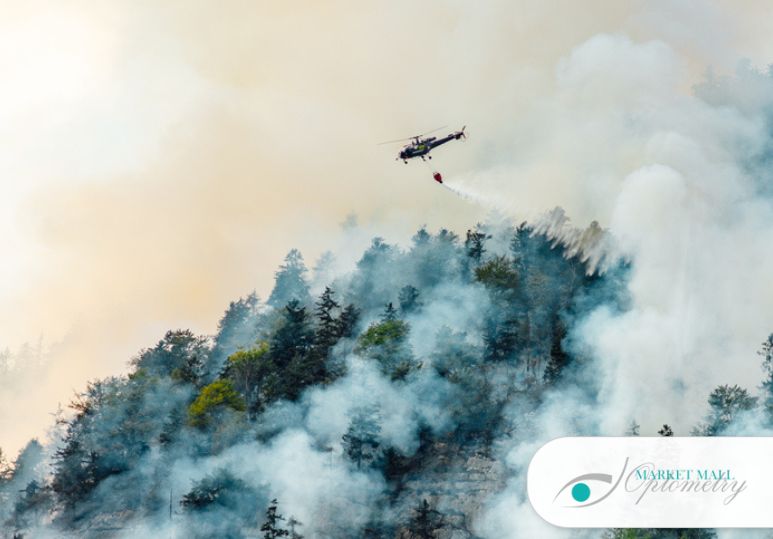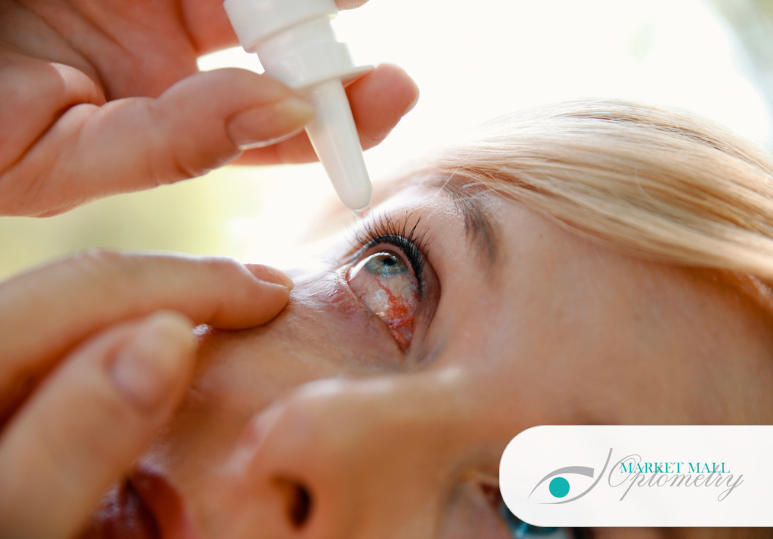What Is Dry Eye Syndrome?
Dry eye syndrome is a common condition characterized by a lack of sufficient lubrication and moisture on the surface of the eyes. It can cause symptoms such as stinging, burning, redness, excessive tearing, and a sensation of grittiness in the eyes. While there are several factors that can contribute to dry eye syndrome, environmental factors, such as smoke and airborne particulate matter, can play a significant role.
The Smoke And Dry Eye Connection
When forest fires occur, large amounts of smoke and particulate matter are released into the atmosphere. These microscopic particles can easily travel long distances, affecting regions far from the actual fire site. When people are exposed to this smoke, the particles can irritate the eyes and disrupt the delicate balance of the tear film, which is responsible for keeping the eyes lubricated and protected.
The smoke from forest fires contains a complex mixture of pollutants, including carbon monoxide, nitrogen oxides, volatile organic compounds (VOCs), and fine particulate matter (PM2.5). These pollutants can cause inflammation and oxidative stress, leading to damage to the ocular surface and worsening of dry eye symptoms. In addition, the high levels of PM2.5 in the air can directly interact with the tear film, reducing its stability and increasing the evaporation of tears, further contributing to dryness.
Several studies have investigated the relationship between forest fire smoke and dry eye symptoms. A study published in the journal Environmental Health Perspectives found that exposure to smoke from the 2003 Southern California wildfires was associated with a significant increase in dry eye symptoms among residents of affected areas. Similarly, a study conducted during the 2015 wildfires in Indonesia showed that individuals exposed to high levels of smoke had a higher prevalence of dry eye symptoms compared to those in areas with lower smoke exposure.
It is important to note that the link between forest fire smoke and dry eye symptoms is not limited to those directly affected by the fires. As mentioned earlier, smoke and particulate matter can travel long distances, affecting regions far from the fire site. This means that individuals living in areas hundreds or even thousands of miles away from the fire can still be exposed to the smoke and experience dry eye symptoms as a result.
What Can You Do?
To protect yourself from the harmful effects of forest fire smoke on your eyes, there are several preventive measures you can take. When there are active fires in your area or nearby, it is advisable to stay indoors and keep windows and doors closed to minimize smoke exposure. Using air purifiers or HEPA filters can help remove smoke particles from indoor air. Additionally, wearing sunglasses or protective goggles when outdoors can provide a physical barrier against the smoke and reduce eye irritation.
If you experience dry eye symptoms during or after exposure to forest fire smoke, it is important to seek medical attention. Your optometrist can evaluate your symptoms, diagnose, provide appropriate treatment, and offer guidance on managing dry eyes in smoky conditions.
Dry Eye Relief At Market Mall Optometry
The link between forest fire smoke and dry eye symptoms is a concerning issue. The microscopic particles and pollutants present in the smoke can irritate the eyes, disrupt the tear film, and worsen dry eye symptoms. Being aware of the potential risks and taking preventive measures to minimize smoke exposure can help protect your eyes and mitigate the impact of forest fire smoke on your ocular health.
Dry eye symptoms can be frustrating and uncomfortable. While there is no definitive cure, it is possible to manage dry eye symptoms. If you are experiencing dry eye symptoms, it's important to talk to your eye doctor for a proper diagnosis and personalized treatment plan. By working together, you can find the right combination of strategies to help you manage your dry eye symptoms and see life comfortably again.
Market Mall Optometry can help reduce your dry eye symptoms. During an eye exam, a Calgary optometrist will determine the cause of your dry eyes and will create a symptom relief plan based on this. For comprehensive and personalized dry eye care, visit the dry eye clinic at Market Mall Optometry in NW Calgary or schedule an eye exam with one of our Calgary optometrists. You can contact Market Mall Optometry at 1-403-286-4884 or fill out the online contact form to set up an eye exam and see the world clearly again.
FAQ
Q: Can forest fire smoke cause long-term damage to the eyes?
A: While forest fire smoke can certainly exacerbate dry eye symptoms, the long-term effects on eye health are still being studied. However, prolonged exposure to smoke and airborne particulate matter can potentially lead to chronic inflammation and oxidative stress, which may have negative consequences for the eyes over time. It is essential to take preventive measures and see your optometrist if you experience persistent dry eye symptoms.
Q: Are certain individuals more susceptible to dry eye symptoms from forest fire smoke?
A: Individual susceptibility to dry eye symptoms from forest fire smoke can vary. Some people may be more sensitive to the irritants and pollutants present in the smoke, while others may have pre-existing dry eye conditions that are exacerbated by the smoke. Factors such as age, overall eye health, and underlying medical conditions can also influence an individual's susceptibility to dry eye symptoms. It is important to monitor your symptoms and take necessary precautions based on your specific situation.
Q: How can I manage dry eye symptoms during periods of increased forest fire activity?
A: During periods of increased forest fire activity, there are several steps you can take to manage dry eye symptoms. Firstly, minimize your exposure to smoke by staying indoors and keeping windows and doors closed. Using air purifiers or HEPA filters in your home can help reduce the amount of smoke particles in the indoor air. Additionally, you can use artificial tears or lubricating eye drops to keep your eyes moist and alleviate dryness. Consulting your eye doctor can provide personalized recommendations for managing dry eye symptoms during smoky conditions.





